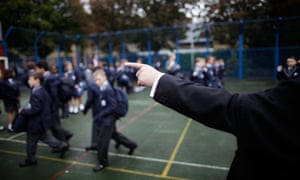
Tens of thousands of children have failed to get into their first choice of secondary school, with almost half of children in some London boroughs losing out as councils scramble to provide enough places to meet growing demand.
At the end of national offer day on Tuesday, when more than half a million children in their final year of primary school find out which secondary school they will be attending in September, thousands learned they had not got into any of their six chosen schools.
Local authorities reported increases in demand for places as the spike in the birth rate, which has been putting pressure on the primary sector, began to take its toll on secondary schools.
Some parents living in areas of high demand said their children could not get into schools a few hundred metres away from their front doors.
The situation was particularly acute in London, where schools are grappling with a 3.3% increase in demand for school places this year. According to the pan-London admissions board, 31% of children failed to get into their first-choice school, though 89% were offered a place at one of their top three choices.
The situation was worst in the London boroughs of Hammersmith and Fulham, where 48% failed to get into their first choice; Westminster, 44%; and Lambeth, 42%.
While 94% of the roughly 81,000 pupils in the capital received a place at one of their six preferred schools (the same percentage as last year), that meant about 4,850 children did not get an offer from any of their choices.
The chair of the pan-London admissions board, Helen Jenner, said: “Demand for secondary school places in the capital is on the rise as the primary pressure works its way through the system.
“Local authorities have worked hard to put in place plans to meet this increased demand so that more pupils are offered a school place of their choice in London.
“Today’s figures show that despite the rise in the number of applications, preference rates have not dropped. In fact, the percentage of pupils that received their first preference place increased slightly.”
“Today’s figures show that despite the rise in the number of applications, preference rates have not dropped. In fact, the percentage of pupils that received their first preference place increased slightly.”
She added: “It is important to recognise that not all parents and pupils can be offered their first preference, because there are simply not an unlimited number of places at each school. However, there are sufficient places in London schools to meet overall demand.”
The Local Government Association, which represents 370 councils, has said its members may not be able to deliver sufficient places in future because their power to open new schools has been removed.
Labour, meanwhile, has said the system is under strain, with one in six secondary schools already at, or over capacity, and 300,000 more secondary pupils set to enter schools by 2020.
The government says it invested £5bn during the last parliament to help create half a million new school places, with a further £7bn set aside to create more places over the next six years.
The final official figures on the allocation of secondary school places in England will not be released by the Department for Education until June, but a familiar pattern began to emerge on Tuesday as local authorities began to publish their own numbers.
In urban areas of high demand there was widespread disappointment, while in areas of low demand virtually all 11-year-olds got a place in their preferred school.
In Birmingham, which has been experiencing acute pressure on places in recent years, 69.2% of pupils were allocated their first choice of schools, slightly up on last year’s figure of 68.5%.
In Bristol, another area of high demand, 77% of children got their first choice, up 2% on 2015. But like last year, 7.5% did not receive an offer from any of their preferences and will be given a place at an alternative school.
In Kent, despite growing demand, almost 400 more children got their first preference than did last year, and more than 97% will receive an offer from one of their top four. But 428 children will be allocated a school by the local authority after failing to get any of their preferred choices.
Research by the Press Association, meanwhile, suggested an overall increase in the number of applications received compared with last year.
According to PA, which surveyed 20 local education authorities, other areas where relatively high numbers of children did not get into their top school included: Southend-on-Sea, where 79% got their first choice; Trafford, where it was 80%; and Bolton at 82%.
At the other end of the spectrum, in East Riding 96.4% of children got their first choice, with just 0.8% failing to get one of their top three schools.
Leicester county council reported similarly high rates of success, with 95.5% of applicants getting their first choice. In Norfolk it was 94.7% and in Sunderland, according to the city council, just 34 children failed to get their first, second or third choices.
Meanwhile, pressure for places means catchment areas around sought-after schools are shrinking. Justine Roberts, chief executive of the parenting website Mums net, said many site users claim they cannot get their children into schools just down the road from home.
“How well the school admissions system works depends almost entirely on where you live,” she said.
“Lots of parents are very content with the school places allocated to their children, but in some areas – parts of London, Bristol, East Sussex and Birmingham, for example – the admissions system is starting to feel seriously creaky.”

No comments:
Post a Comment